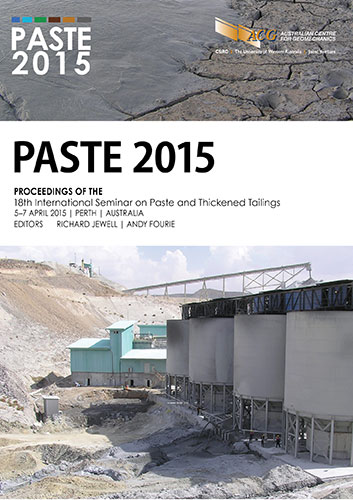The high density thickened discharge tailings storage facility at Osborne Mine – a case history from inception to closure

|
Authors: McPhail, GI |
DOI https://doi.org/10.36487/ACG_rep/1504_0.2_McPhail
Cite As:
McPhail, GI 2015, 'The high density thickened discharge tailings storage facility at Osborne Mine – a case history from inception to closure', in R Jewell & AB Fourie (eds), Paste 2015: Proceedings of the 18th International Seminar on Paste and Thickened Tailings, Australian Centre for Geomechanics, Perth, pp. 13-41, https://doi.org/10.36487/ACG_rep/1504_0.2_McPhail
Abstract:
Chinova Resources Pty Ltd’s Osborne Mine is located in Northern Queensland, approximately 800 km inland from the eastern coast. It commenced operations in 1995 with the development of an open pit mine. In 1996, the operation transitioned to underground mining. In 2015, Osborne will have been in operation for 20 years and will have mined 29 Mt of ore. The site has produced 672, 420 t of copper and 673,295 oz of gold. Osborne Mine produces approximately 112,000 t of tailings per month. In 2003, following progressive evaluation and development of a high-density discharge tailings management system, Osborne implemented the first of two trial depositions forming advancing cones of deposited tailings within their TSF2 site. These trials proved successful and, following successful permit applications to the regulators, TSF2 was converted to high-density thickened tailings discharge. The principal benefit of this change was in the reduction of construction costs for confining embankments. However, an additional major benefit lay in a reduction of make-up water volumes. The majority of water loss in the process water circuit occurs in the tailings system as a result of evaporation. High-density thickened discharge provides a means for significantly reducing water losses, since, by recovering and re-using more water at the thickener and in the plant, less water is discharged onto the tailings facility so there is less water available for evaporation. High density thickened discharge also enabled a significant improvement in operating costs. High-density thickened discharge operations at Osborne have had to be continuously modified and adjusted as ores from satellite mines have been processed to supplement the diminishing Osborne Mine ore. Mineralogical influences of the supplementary ore significantly affect the thickening and beaching characteristics of the tailings slurry, particularly in the most recent operating period. However, through appropriate modifications and adjustments, the benefits of high-density thickened discharge have been retained. The resulting tailings storage facility (TSF) landform is that of a shallow-sloped shedding mound so that there is no need to retain water on the TSF. Chinova has been proactive with ongoing site monitoring and rehabilitation with a view to shedding runoff to the environment. Their site plans include ensuring that the discharge water from the site will meet the stock-water guidelines, and that the erosion gullies forming in TSF cover materials or on the side slopes of confining embankments will not result in exposure of the tailings over 500 years.
References:
Charlebois, LE, McPhail, GI, Revington, A & van Zyl, D 2013, ‘Observations of tailings flow and application of the McPhail Beach Profile Model to oil sands and metal mine tailings’, in GW Wilson, DC Sego & NA Beier (eds), Proceedings of Tailings and Mine Waste ‘13, University of Alberta Geotechnical Center, Edmonton, pp. 169-180.
McPhail, GI 1995, ‘Prediction of the beaching characteristics of hydraulically placed tailings’, PhD thesis, University of the Witwatersrand.
McPhail, GI, Papageorgiou, G, Noble A & Wilkinson, D 2004, ‘Development and implementation of thickened tailings discharge at Osborne Mine, Queensland, Australia’, Proceedings of the 7th International Seminar on Paste and Thickened Tailings, Australian Centre for Geomechanics, Perth.
McPhail, GI 2008, ‘Prediction of the beach profile of high density thickened tailings from rheological and small scale trial deposition data’, in AB Fourie, RJ Jewell, PT Slatter & A Paterson (eds), Proceedings of the 11th International Seminar on Paste and Thickened Tailings, Australian Centre for Geomechanics, Perth, pp. 179-188.
McPhail, GI 2014, ‘Using small scale flumes to determine rheology at low shear rates’, in S Barrera (ed.), Proceedings of the 2nd International Seminar on Tailings management, Gecamin, Santiago.
Papageorgiou, G 2003, ‘Flow failure and static liquefaction of gold and platinum tailings’, PhD thesis, University of the Witwatersrand.
Willgoose, GR 1989, ‘A physically based channel network and catchment evolution model’, PhD thesis, Massachusetts Institute of Technology.
© Copyright 2025, Australian Centre for Geomechanics (ACG), The University of Western Australia. All rights reserved.
View copyright/legal information
Please direct any queries or error reports to repository-acg@uwa.edu.au
View copyright/legal information
Please direct any queries or error reports to repository-acg@uwa.edu.au